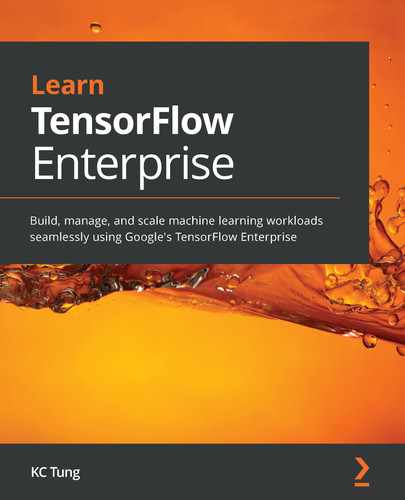Use TensorFlow Enterprise with other GCP services to improve the speed and efficiency of machine learning pipelines for reliable and stable enterprise-level deployment TensorFlow as a machine learning (ML) library has matured into a production-ready ecosystem. This beginner's book uses practical examples to enable you to build and deploy TensorFlow models using optimal settings that ensure long-term support without having to worry about library deprecation or being left behind when it comes to bug fixes or workarounds. The book begins by showing you how to refine your TensorFlow project and set it up for enterprise-level deployment. You'll then learn how to choose a future-proof version of TensorFlow. As you advance, you'll find out how to build and deploy models in a robust and stable environment by following recommended practices made available in TensorFlow Enterprise. This book also teaches you how to manage your services better and enhance the performance and reliability of your artificial intelligence (AI) applications. You'll discover how to use various enterprise-ready services to accelerate your ML and AI workflows on Google Cloud Platform (GCP). Finally, you'll scale your ML models and handle heavy workloads across CPUs, GPUs, and Cloud TPUs. By the end of this TensorFlow book, you'll have learned the patterns needed for TensorFlow Enterprise model development, data pipelines, training, and deployment. This book is for data scientists, machine learning developers or engineers, and cloud practitioners who want to learn and implement various services and features offered by TensorFlow Enterprise from scratch. Basic knowledge of the machine learning development process will be useful.Key Features
Book Description
What you will learn
Who this book is for
Table of Contents
- Learn TensorFlow Enterprise
- Why subscribe?
- Contributors
- About the author
- About the reviewers
- Packt is searching for authors like you
- Preface
- Section 1 – TensorFlow Enterprise Services and Features
- Chapter 1: Overview of TensorFlow Enterprise
- Understanding TensorFlow Enterprise
- TensorFlow Enterprise packages
- Configuring cloud environments for TensorFlow Enterprise
- Setting up a cloud environment
- Creating a Google Cloud Storage bucket
- Enabling APIs
- Creating a data warehouse
- Using TensorFlow Enterprise in AI Platform
- Accessing the data sources
- Cloud Storage Reader
- BigQuery Reader
- Persisting data in BigQuery
- Persisting data in a storage bucket
- Summary
- Chapter 2: Running TensorFlow Enterprise in Google AI Platform
- Section 2 – Data Preprocessing and Modeling
- Chapter 3: Data Preparation and Manipulation Techniques
- Converting tabular data to a TensorFlow dataset
- Converting a BigQuery table to a TensorFlow dataset
- Converting distributed CSV files to a TensorFlow dataset
- Preparing an example CSV
- Building filename patterns with TensorFlow I/O
- Creating a dataset from CSV files
- Inspecting the dataset
- Handling image data for input pipelines
- Constructing a protobuf message
- Decoding TFRecord and reconstructing the image
- Handling image data at scale
- Executing the steps
- Reading TFRecord and displaying it as images
- Summary
- Chapter 4: Reusable Models and Scalable Data Pipelines
- Using TensorFlow Hub
- Applying models from TensorFlow Hub
- Creating a generator to feed image data at scale
- Reusing pretrained ResNet feature vectors
- Compiling the model
- Training the model
- Scoring with test images
- Leveraging the TensorFlow Keras API
- Data acquisition
- Solving a data science problem with the us_border_volumes table
- Selecting features and a target for model training
- Streaming training data
- Input to a model
- Model training
- Working with TensorFlow Estimators
- Data pipeline for TensorFlow Estimators
- Summary
- Section 3 – Scaling and Tuning ML Works
- Chapter 5: Training at Scale
- Using the Cloud TPU through AI Platform
- Installing the Cloud SDK
- Whitelisting access for reading training data and writing artifacts (alternative)
- Execution command and format
- Cloud command arguments
- Organizing the training script
- Data streaming pipeline
- Submitting the training script
- Working with models in TensorFlow Hub
- Using the Google Cloud GPU through AI Platform
- Summary
- Chapter 6: Hyperparameter Tuning
- Technical requirements
- Delineating hyperparameter types
- Understanding the syntax and use of Keras Tuner
- Using hp.Int for hyperparameter definition
- Using hp.Choice for hyperparameter definition
- Using hp.Float for hyperparameter definition
- Delineating hyperparameter search algorithms
- Hyperband
- Bayesian optimization
- Random search
- Submitting tuning jobs in a local environment
- Submitting tuning jobs in Google's AI Platform
- Summary
- Section 4 – Model Optimization and Deployment
- Chapter 7: Model Optimization
- Technical requirements
- Understanding the quantization concept
- Training a baseline model
- Preparing a full original model for scoring
- Preparing test data
- Loading test data
- Scoring a single image with a full model
- Scoring batch images with a full model
- Converting a full model to a reduced float16 model
- Preparing the reduced float16 model for scoring
- Scoring a single image with a quantized model
- Scoring a batch image with a quantized model
- Converting a full model to a reduced hybrid quantization model
- Preparing test data for scoring
- Mapping a prediction to a class name
- Scoring with a hybrid quantization model
- Scoring a single image
- Scoring batch images
- Converting a full model to an integer quantization model
- Training a full model
- Scoring with an integer quantization model
- Preparing a test dataset for scoring
- Scoring batch images
- Summary
- Chapter 8: Best Practices for Model Training and Performance
- Chapter 9: Serving a TensorFlow Model
- Other Books You May Enjoy
